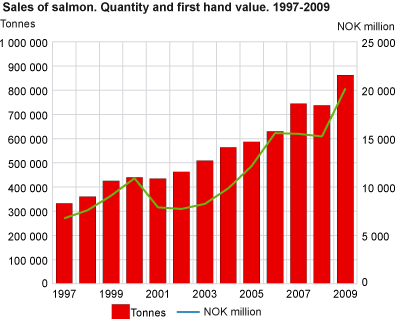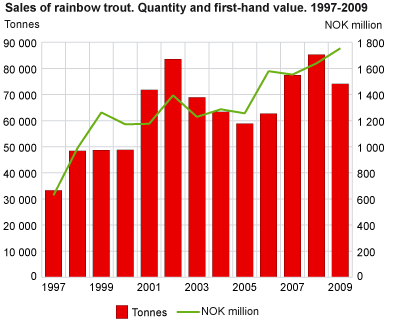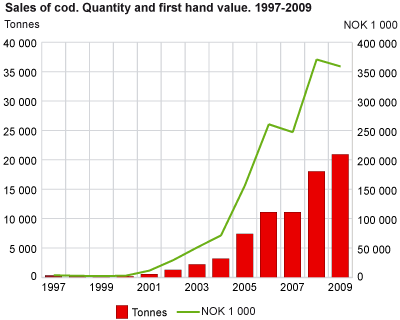Content
Published:
This is an archived release.
Strong growth in aqua culture
The growth in production and sales of reared fish continued in 2009. Almost one million tonne of fish with a first hand value of NOK 22.4 billions was sold.
The final figures show only minor changes compared with the preliminary figures, but confirm 2009 as a top year for fish farming.
Salmon still strong
Salmon was still the main product, and represented about 90 per cent of the total quantity of reared fish. The first hand value of salmon increased by 33 per cent compared to 2008, and reached NOK 20.2 billion.
The first hand value of rainbow trout also increased in 2009. In spite of a 13 per cent fall in sales quantity, the first hand value rose by 7 per cent.
Falling cod prices
Cod farming experienced the opposite situation, with more fish but falling prices. From 2008 to 2009 the quantity increased by 16 per cent, as the value fell by 3 per cent.
More licences
The high production also effected employment and the number of licences. In production of salmonid fish for food, 68 more licences were running and 216 more persons were occupied in 2009 than the previous year. Other species in the fish for food production had a slight drop in both number of employees and licences compared to 2008.
Hatcheries and fingerling production as a whole had a rise in employment by 115 persons. In total, 5 067 persons were employed in aquaculture in 2009, and 65 per cent of these worked with fish for food production.
Loss on the same level
For 2009, the magnitude of loss was almost the same as in 2008. Round 80 per cent of the loss was caused by disease, and can be explained by the salmon louse ( Lepeophtheirus salmoni ) situation in 2009. Trout had the lowest loss with 6.2 per cent.
Downward trend for shellfish
The shellfish industry has experienced a downward trend since 2005. From 2008 to 2009 the quantity fell by 16 per cent, whereas the sales fell by 7 per cent.
Tables:
- Table 1 Sales of slaughtered fish for food. Quantity, by fish species and county, 2009. Tonnes
- Table 2 Sales of slaughtered fish for food. Value, by fish species and county. 2009. NOK 1 000
- Table 3 Number of licenses running, workers and labour input, by type of production and county. Salmon and rainbow trout. 2009
- Table 4 Number of licences running, workers and labour input, by type of production and county. Other fish species than salmon and rainbow trout. 2009
- Table 5 Stock of live fish for food, by species of fish and county. All fish species. 2009. 1 000 pieces
- Table 6 Sales of shellfish, by fish species. 2000-2009. Tonnes and NOK 1000
Contact
-
Statistics Norway's Information Centre
E-mail: informasjon@ssb.no
tel.: (+47) 21 09 46 42



